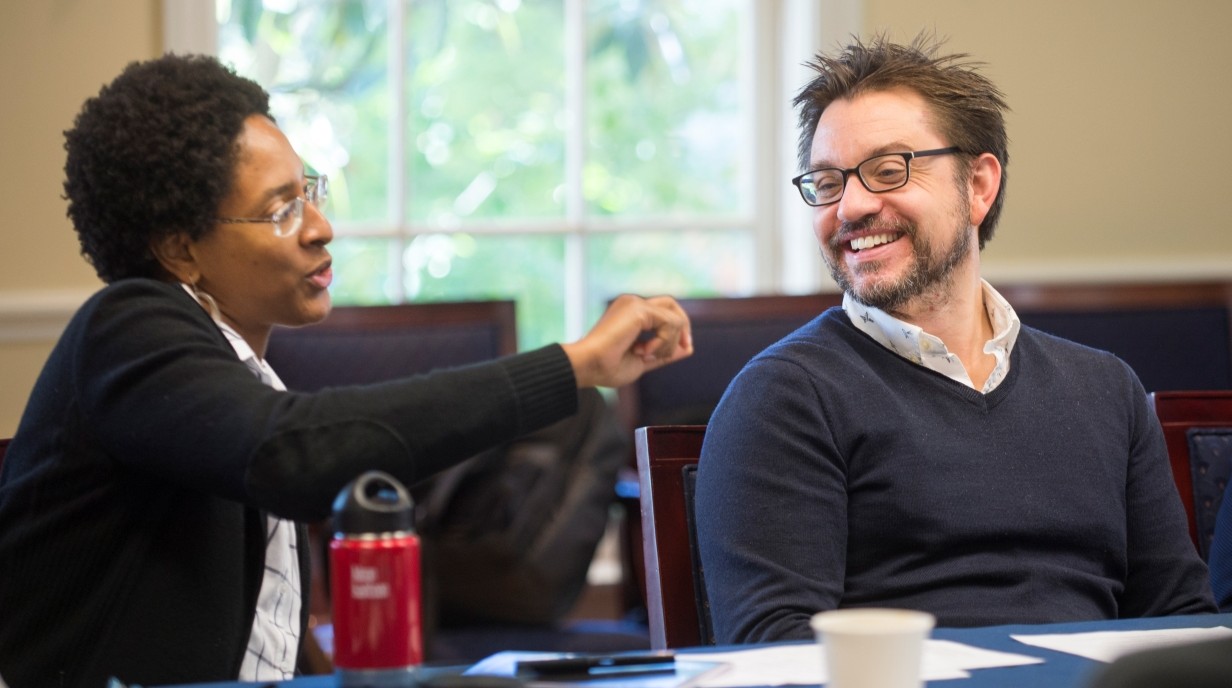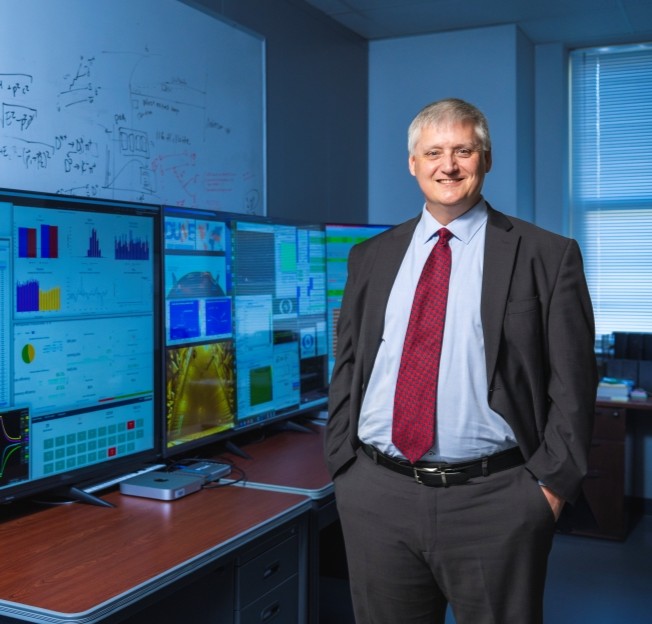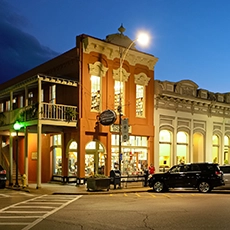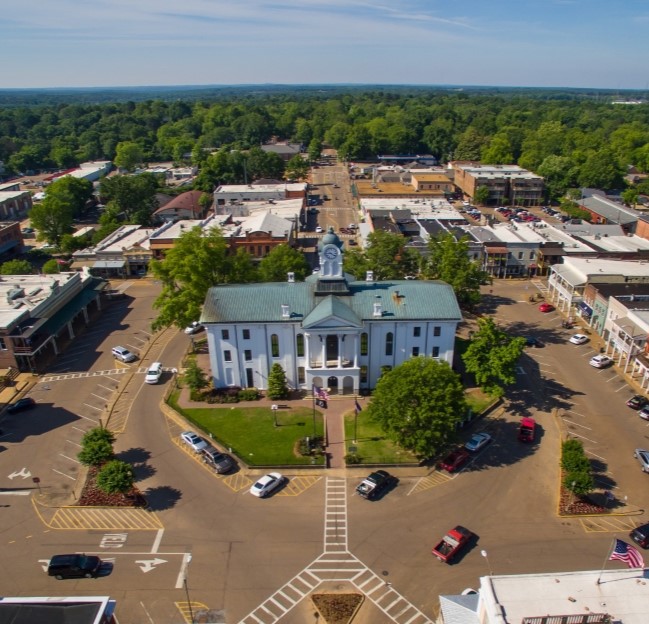About the Department of Physics and Astronomy
- Home
- Departmental Directory
- Liberal Arts
- Department of Physics and Astronomy
- About the Department of Physics and Astronomy

The Department of Physics and Astronomy
What We Do
Our physics majors acquire a broad understanding of the physical principles of nature, develop critical thinking and quantitative reasoning skills and become creative scientific thinkers. They work close with experienced faculty in a supportive department that offers opportunities for collaboration and research throughout the year. Students apply this knowledge in ways to advance strong communication and analytical skills.
Who We Are
The University of Mississippi is categorized as an R1 research institution, which means that our faculty are at the top of their fields and actively conducting groundbreaking research. It also means students work and study alongside some of the best.
Our faculty members include award-winning educators and researchers with years of experience. Our department boasts particular strengths in the areas of Condensed Matter Physics, Gravitational Physics, High Energy Physics, and Physical Acoustics.
What We Offer
GRAD
Gain training at the leading-edge of ideas in science, technology, academia, and government.
- Oxford
GRAD
Be prepared to pursue professional careers in physics, either in academia, as research physicists, or in industry careers.
- Oxford
Welcome from the Department Chair
The Department of Physics and Astronomy offers exciting courses of study at the undergraduate and graduate level. Our faculty are deeply committed to their exceptional scholarship and to high-quality teaching and mentoring. The research enterprise covers everything from tabletop experiments in the lab to particle colliders and gravitational wave detectors run as vast international collaborations; from paper-and-pencil theory to simulations on high-performance computing clusters. Students at all levels can easily find ways to connect with frontier research opportunities in condensed matter physics, gravity, high energy physics, and physical acoustics. We are proud that the University of Mississippi carries the R1 Carnegie designation reserved for doctoral universities with the highest level of research activity.
Kevin S D Beach
Chair and Associate Professor of Physics and Astronomy
Leadership and Support
Meet the faculty and staff who support the faculty and students in the Department of Physics and Astronomy.
Kevin Beach
- Chair and Associate Professor of Physics and Astronomy
Gavin Davies
- Associate Professor of Physics and Astronomy and Graduate Program Coordinator
Joel Mobley
- Professor of Physics and Astronomy and Undergraduate Program Coordinator: Senior Scientist I at the National Center for Physical Acoustics
Emily Hollowell
- Administrative Assistant
Heather McBride
- Operations Coordinator Physics
Richard Watkins
- Machine Shop Manager
Condensed Matter Physics Faculty
Faculty who work in the subfield of condensed matter physics.
Kevin Beach
- Chair and Associate Professor of Physics and Astronomy
Igor Ostrovskii
- Professor of Physics & Astronomy
High Energy Faculty
Faculty who work in the subfield of high energy/particle physics.
Jake Bennett
- Associate Professor of Physics and Astronomy
Alakabha Datta
- Professor of Physics and Astronomy
Gavin Davies
- Associate Professor of Physics and Astronomy and Graduate Program Coordinator
Gene Quinn
- Profess of Physics and Astronomy and Director of the Center for Multimessenger Astrophysics
Gravity and Astrophysics Faculty
Faculty who work in the subfield of gravity and astrophysics.
Luca Bombelli
- Professor of Physics and Astronomy
James Bonifacio
- Assistant Professor of Physics and Astronomy
Anuradha Gupta
- Assistant Professor of Physics & Astronomy
Nicholas MacDonald
- Assistant Professor of Physics and Astronomy
Leo Stein
- Associate Professor of Physics and Astronomy
Physical Acoustics Faculty
Faculty who work in the subfield of physical acoustics.
Cecille Labuda
- Associate Professor of Physics & Astronomy
Joel Mobley
- Professor of Physics and Astronomy and Undergraduate Program Coordinator: Senior Scientist I at the National Center for Physical Acoustics
Likun Zhang
- Associate Professor of Physics and Astronomy; Senior Scientist I at the National Center for Physical Acoustics
Instructional Faculty
Meet the faculty who provide critical teaching support in physics and with the astronomy minor.
Kelvin Au
- Instructional Assistant Professor of Physics and Astronomy
Nathan Davis
- Instructional Assistant Professor of Physics and Astronomy
Jennifer Meyer
- Instructional Associate Professor of Physics and Astronomy
Ray Siedlecki
- Laboratory Physicist
Tibor Torma
- Director of Kennon Observatory and Research Assistant Professor of Physics & Astronomy
Bin Xiao
- Instructional Associate Professor of Physics and Astronomy
Research Faculty and Associates
Zhiqu Lu
- Senior Research Scientist II and Research Associate Professor of Physics
Wayne Prather
- Principal Scientist at the National Center for Physical Acoustics and Research Associate Professor of Physics
David Sanders
- Computational Physicist and Research Scientist
Roger Waxler
- Principal Scientist and Research Associate Professor of Physics & Astronomy
Francesco Bertucci
- Postdoctoral Research Associate
Francesco Bertucci
- Postdoctoral Research Associate
Francesco Bertucci
- Postdoctoral Research Associate
Jeffrey Kleykamp
- Postdoctoral Research Associate
Adjuncts
| Purnima Narayan | Instructor, Temporary | pnarayan@olemiss.edu |
| Joshua Moore | Graduate Intern II | jmoore10@olemiss.edu |
Emeritus Faculty
| Dr. Kumar Bhatt | Dr. Thomas Marshall |
| Dr. Lucien Cremaldi | Dr. James Reidy |
| Dr. Ken Gilbert | Dr. Jim Sabatier |
| Dr. Robert Kroeger | Dr. Maribeth Stolzenburg |
Research Center

Center for Multi-Messenger Astrophysics
The Center allows UM researchers to play a prominent role in the emergent field of multi-messenger astrophysics, which is a new branch of science born in 2015 through the discovery of gravitational waves by the Laser Interferometer Gravitational-wave Observatory, or LIGO. The Center enhances the retention of high-profile faculty and students and serves the community through education and public outreach initiatives.
Facilities
The Department of Physics and Astronomy is located in Lewis Hall and Kennon Observatory. There are some research labs and offices in the National Center for Physical Acoustics. There are teaching labs and a few offices in the Jim and Thomas Duff Center for Science and Technology Innovation building.
Lewis Hall, completed in 1939, was one of the last constructions of the Works Progress Administration set up during the Great Depression. In 1995 a research wing was added to the building.
Lewis Hall houses all upper-level physics undergraduate and graduate classes and labs. Faculty and graduate students have offices, research spaces and labs in Lewis. There is a student lounge for physics and astronomy majors and minors. A collection of meteorites and several pieces of finely-crafted, classic physics demonstration equipment are displayed in the building hallways with the rest of the collection at the University Museum. The staircase railings from the first floor to the basement have wrought-iron inserts which can be used for a geometric proof of Pythagoras' theorem.
History of Dr. Lewis
The building is named for Dr. Arthur Beverly Lewis, whose career at UM began as a physics undergraduate student in 1919 and continued as a physics professor from 1936 to 1969. Dr. Lewis was Chair of the Department from 1953 to 1957 and Dean of the College of Liberal Arts from 1957 to 1969. He donated his collection of Physics Abstracts, a journal with articles spanning much of the development of high voltage physics, to the department in 1998. The 40 years-worth of bound journals can be viewed, along with a reprint given to us by Dr. Lewis of the National Bureau of Standards Research Paper "Standard Electrodynamic Wattmeter and AC-DC Transfer Instrument" by J. H. Park and A. B. Lewis. Dr. Lewis died in May 2000, at the age of 98 and is missed by all who knew him.
The Lewis Hall Machine Shop serves as a resource for the Department of Physics and Astronomy, other UM departments, and to physics colleagues around the country. The shop designs and fabricates small devices, parts and equipment for benchtop laboratory experiments as well as for the largest experimental collaborations in the world.
Design is carried out using AutoCad and a variety of CAM software to support our CNC (Computer Numerically Controlled) machines. Implementation is accomplished by modern collaboration techniques that follow the process from design, through manufacturing, quality control, and finally shipment to our customers.
We are located in room 20 on the first floor of Lewis Hall's research wing.
Phone: (662) 915-5327
Email: shop@phy.olemiss.edu
Kennon Observatory, conceived by Professor William Lee Kennon, was completed in 1939 and has two copper-roofed domes to accommodate different instruments. The main entrance of the observatory faces due south, and the building is precisely aligned east to west. The design in the railing in front of the Observatory illustrates the Pythagorean theorem. A small tube in the south wall is oriented such that direct rays of the sun shine through it to the floor only twice a year, at noon on the vernal and autumnal equinoxes. The slanted metal roof of the transit room (between the main and small domes) was designed to open for observations using a three inch meridian telescope.
The larger dome houses a refractor telescope that was purchased from the Sr. Howard Grubb Co. in 1893. It consists of 3 co-aligned visual and photographic telescopes; a fifteen-inch f/12 visual telescope, a nine-inch photographic telescope, and a four-inch visual telescope.
The smaller dome houses a seventeen-inch f/6.8 Plane Wave, Corrected Dall-Kirkham (CDK) reflector telescope purchased through the Ole Miss Astronomy Legacy Project. It has an electronic CCD camera, the SBIG ST10 with an AO-7 adaptive optics accessory, and attached Paramount ME. Students use this telescope for astrophotography or for viewing galaxies, nebulae, and other objects in introductory physics courses.
About Dr. William Lee Kennon
The untimely death of Dr. Kennon in 1952, after 41 years of distinguished service to the department and the university, prompted the Board of Trustees to name the observatory the 'William Lee Kennon Observatory.' Dr. Kennon was Chair of Physics and Astronomy for 40 years and was popular with and respected by students and faculty alike. His influence is still felt throughout the department. His careful planning of the physics buildings, his successful efforts to attain funding for new demonstration and laboratory equipment, his commitment to the growth of the curriculum, and his nurturing of the students are all Dr. Kennon's legacy.
The National Center for Physical Acoustics (NCPA) was born out of the Physical Acoustics Research Group, which consisted of a group of researchers in the Department of Physics and Astronomy. NCPA was established by an act of Congress in 1987 with a mandate to conduct and transfer scientific research into usable technology for government and commercial applications. The Center has since led the way in exploring a vast array of applications, from infrasound to ultrasound and more, setting benchmarks in research excellence. It is housed in an expansive 85,000-square-foot facility on the University of Mississippi Oxford campus. While NCPA has grown far beyond the Department of Physics and Astronomy, the two units maintain close connections to this day. Physical Acoustics remains a major research area in the department and faculty doing research in that area have have affiliations with the Center.
The Jim and Thomas Duff Center for Science and Technology Innovation is the newest academic building dedicated to STEM education. It opened for classes in Fall 2024. It houses innovative lab spaces, classrooms, and student collaboration and study spaces.
The Department of Physics and Astronomy teaches many courses in the new building, including in a 120-seat auditorium with attached storage for demonstration equipment, dedicated TEAL (technology-enhanced, active learning) rooms, and dedicated lab rooms.
Our Community


A Place That Ever Calls
Located 70 miles from Memphis and surrounded by the natural beauty of Northern Mississippi, Oxford boasts thriving music, art, and literary scenes along with great restaurants. University of Mississippi athletics provides many opportunities to watch and participate in sports—and one of the world’s best tailgating parties.
With everything Oxford offers, it’s no wonder USA Today names Oxford as one of the Top Six College Towns in the Nation.
Come see why.
